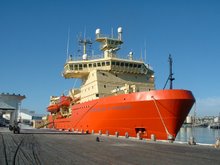My sister is teaching at a elementary school in Philly this semester. I volunteered to answer some questions about Antarctica for my sister's group of 7 and 8 year olds. The transcript is posted below:
1) Hans asks: Are you going to see B-15? (n.b. a very large iceberg)
3) Alex asks: Have you seen any icebergs?
5) Tr. Debby asks: Does your ship have safety measures for when you encounter icebergs? How do you safely cruise in the water with all that ice?
We've been around a big portion of the coast of Antarctica (almost halfway around the world, which is smaller near the south pole than it is around the equator) and there are very few days when we haven't seen icebergs. They are amazing and come in all shapes and sizes and colors. Although we break through sea ice up to 10 feet thick, we stay away from icebergs, which can be over 1000 feet thick (most of which is underwater). We are very careful not to hit them -- we steer around them during the day and have special radar that detects them at night. Also the crew run on shifts like the scientists...there is always someone awake watching where we're going, usually two people.
It sounds like Hans may know more about B-15 than I do. But here's what I know. The iceberg broke off of the Ross Ice Shelf a few years ago. We were near that ice shelf for almost 1 week. It then went out to near Cape Adare (the northwesternmost point of the Ross Sea) of where it got grounded (stuck on the bottom) and broke up into B-15A, B, C, etc. We went to Cape Adare at the very beginning of the cruise (when we got stuck in a big storm) and may have seen some remnants of B-15 (small pieces of bergs are called bergy bits or growlers). There is a place near there called the "iceberg graveyard" where a lot of "bergs" get stuck on the bottom. But I think most of it is now either melted or somewhere in the Southern Ocean. PS there is a website called nsidc.org that tracks ice shelves and icebergs...
2) Hans also wants to know: Did you see any other stations (besides McMurdo) on your cruise?
I didn't get to see any other stations on Antarctica, but I do get to see puerto arenas (in Chile) and christchurch in NZ which a lot of people leave from. Maybe when I go back I'll get to go somewhere esle. PS the US has 3 bases on Antarctica -- McMurdo, South Pole, and Palmer. Many other countries have bases too, but McMurdo is the largest.
4) Robbie wants to know: With all that snow, do you ski or snowboard? :)
I do! But there's no downhill skiing on the ship or on land. There are a lot of cross country skiing trails around Mc Murdo, and some adventurers have skiied across the entire continent. You need to be very careful because the ice is filled with crevasses (big holes in the ice!
6) Nola asks: How do you eat anything in all that cold? Where does your food come from? (the class is convinced that you are eating ice fish, since I told them that there aren't any grocery stores in Antarctica)
It takes a lot of people and coordination to keep people in antarctica happy and well-fed. On the ship, they do an enormous shopping trip (three months worth) before the cruise leaves port. On Antarctica, everytime they fly down they bring food and "freshies" (fresh veggies and fruit) . Also, they have a greenhouse in McMurdo and at the South Pole (!) where they can grow fresh vegetables and fruit. We are definitely running low on fresh food because once we leave port, we only have what's on the ship. Most of the stuff we are eating has been frozen or is non-perishable, but still yummy. especially the desserts!
7) Anna wants to know how long do penguins live?
I had to do some research on this one! I looked in three books on the ship and none of them said how long they live for. Then I asked most of the people on the ship. Most people thought 8-12 years but I honestly have no idea. Maybe one of the kids can do some research on the one??
Sorry Anna!


No comments:
Post a Comment